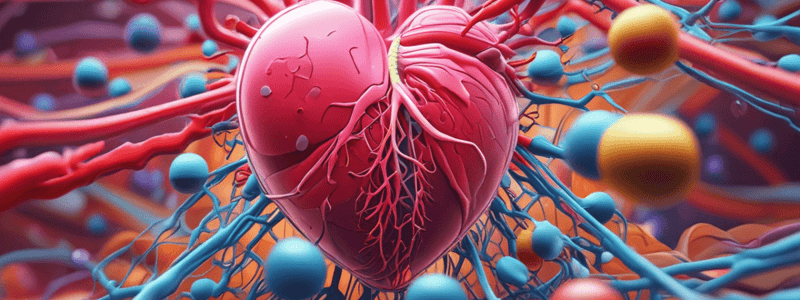Podcast
Questions and Answers
Which nursing implication is important when administering Quinidine?
Which nursing implication is important when administering Quinidine?
- Monitoring potassium levels (correct)
- Avoiding dairy products
- Checking for skin discoloration
- Giving on an empty stomach
What is a common adverse effect of Lidocaine (Xylocaine) usage?
What is a common adverse effect of Lidocaine (Xylocaine) usage?
- Respiratory depression
- Hyperglycemia
- Neurological symptoms like dizziness and confusion (correct)
- Hypertension
What is the primary action of Beta Blockers in the heart?
What is the primary action of Beta Blockers in the heart?
- Stimulate epinephrine production
- Increase heart rate
- Lengthen the action potential of myocardial cells
- Block the sympathetic response in the heart (correct)
What is the primary indication for Amiodarone (Pacerone, Nexterone)?
What is the primary indication for Amiodarone (Pacerone, Nexterone)?
What is a common adverse effect of Verapamil (Calan) and Diltiazem (Cardizem)?
What is a common adverse effect of Verapamil (Calan) and Diltiazem (Cardizem)?
Why is it important to monitor kidney function when administering antiarrhythmics?
Why is it important to monitor kidney function when administering antiarrhythmics?
Which class of drugs blocks sodium movement into myocardial cells?
Which class of drugs blocks sodium movement into myocardial cells?
What is a common adverse effect of Flecainide (Tambocor) and Propafenone (Rythmol)?
What is a common adverse effect of Flecainide (Tambocor) and Propafenone (Rythmol)?
When administering Disopyramide (Norpace), what should the nurse monitor closely?
When administering Disopyramide (Norpace), what should the nurse monitor closely?
What is a common nursing implication when administering Digoxin (Lanoxin)?
What is a common nursing implication when administering Digoxin (Lanoxin)?
Which of the following is NOT a mechanism of action for cardiotonic drugs?
Which of the following is NOT a mechanism of action for cardiotonic drugs?
Which of the following is the LEAST accurate statement regarding the loading dose of digitalis?
Which of the following is the LEAST accurate statement regarding the loading dose of digitalis?
Which of the following is NOT a factor that predisposes a patient to digoxin toxicity?
Which of the following is NOT a factor that predisposes a patient to digoxin toxicity?
Which of the following is the MOST accurate statement regarding the therapeutic serum digoxin levels?
Which of the following is the MOST accurate statement regarding the therapeutic serum digoxin levels?
Which of the following is the BEST initial treatment for digoxin toxicity-induced bradycardia?
Which of the following is the BEST initial treatment for digoxin toxicity-induced bradycardia?
Which of the following is the MOST accurate statement regarding the mechanism of action of Digoxin Immune Fab (Digibind)?
Which of the following is the MOST accurate statement regarding the mechanism of action of Digoxin Immune Fab (Digibind)?
Which of the following is an EARLY sign of digoxin toxicity?
Which of the following is an EARLY sign of digoxin toxicity?
Which of the following is the MOST accurate statement regarding the administration of digitalis?
Which of the following is the MOST accurate statement regarding the administration of digitalis?
Which of the following is NOT a contraindication for the use of digoxin?
Which of the following is NOT a contraindication for the use of digoxin?
Which of the following is the MOST accurate statement regarding the adverse reactions of digoxin?
Which of the following is the MOST accurate statement regarding the adverse reactions of digoxin?
What is the primary indication for Phosphodiesterase Inhibitors?
What is the primary indication for Phosphodiesterase Inhibitors?
Which drug is a Class I-A Sodium Channel Blocker derived from Cinchona bark?
Which drug is a Class I-A Sodium Channel Blocker derived from Cinchona bark?
What is a common adverse effect of Mexiletine, a Class I-B drug?
What is a common adverse effect of Mexiletine, a Class I-B drug?
Which of the following is an action of Amiodarone (Pacerone, Nexterone)?
Which of the following is an action of Amiodarone (Pacerone, Nexterone)?
What is a common adverse effect of Flecainide (Tambocor) and Propafenone (Rythmol)?
What is a common adverse effect of Flecainide (Tambocor) and Propafenone (Rythmol)?
Which of the following is true regarding Beta Blockers?
Which of the following is true regarding Beta Blockers?
What is a potential adverse effect associated with Class IV - Ca Channel Blockers?
What is a potential adverse effect associated with Class IV - Ca Channel Blockers?
Which antiarrhythmic drug is derived from Cinchona bark?
Which antiarrhythmic drug is derived from Cinchona bark?
What is the primary action of Phosphodiesterase Inhibitors in the heart?
What is the primary action of Phosphodiesterase Inhibitors in the heart?
What is a common nursing implication when administering Disopyramide?
What is a common nursing implication when administering Disopyramide?
Which of the following statements about the route and dosing of cardiotonics is INCORRECT?
Which of the following statements about the route and dosing of cardiotonics is INCORRECT?
Which of the following is NOT a factor that can predispose a patient to digoxin toxicity?
Which of the following is NOT a factor that can predispose a patient to digoxin toxicity?
Which of the following is the RECOMMENDED initial treatment for digoxin toxicity-induced bradycardia?
Which of the following is the RECOMMENDED initial treatment for digoxin toxicity-induced bradycardia?
Which of the following adverse reactions is NOT associated with digoxin toxicity?
Which of the following adverse reactions is NOT associated with digoxin toxicity?
Which of the following statements about the mechanism of action of cardiotonics is INCORRECT?
Which of the following statements about the mechanism of action of cardiotonics is INCORRECT?
Which of the following conditions is NOT listed as an indication for the use of cardiotonics?
Which of the following conditions is NOT listed as an indication for the use of cardiotonics?
Which of the following statements about the treatment of digoxin toxicity is CORRECT?
Which of the following statements about the treatment of digoxin toxicity is CORRECT?
Which of the following statements about the adverse reactions of digoxin is INCORRECT?
Which of the following statements about the adverse reactions of digoxin is INCORRECT?
Which of the following factors is NOT listed as a contraindication for the use of digoxin?
Which of the following factors is NOT listed as a contraindication for the use of digoxin?
Which of the following statements about the administration of cardiotonics is CORRECT?
Which of the following statements about the administration of cardiotonics is CORRECT?
What is the primary mechanism of action of cardiotonics?
What is the primary mechanism of action of cardiotonics?
Which electrolyte imbalance is NOT a predisposing factor for digoxin toxicity?
Which electrolyte imbalance is NOT a predisposing factor for digoxin toxicity?
What visual disturbances are associated with digoxin toxicity?
What visual disturbances are associated with digoxin toxicity?
What is the therapeutic range for serum digoxin levels?
What is the therapeutic range for serum digoxin levels?
Which adverse reaction is an early sign of digoxin toxicity?
Which adverse reaction is an early sign of digoxin toxicity?
What is the antidote for serious digoxin toxicity?
What is the antidote for serious digoxin toxicity?
Which condition does NOT predispose a patient to digoxin toxicity?
Which condition does NOT predispose a patient to digoxin toxicity?
What is the loading dose range for digitalization with cardiotonics?
What is the loading dose range for digitalization with cardiotonics?
What is the primary action of Potassium channel blockers in the heart?
What is the primary action of Potassium channel blockers in the heart?
Which antiarrhythmic drug is known for its vasodilating properties and its ability to decrease heart rate and contractility of the left ventricles?
Which antiarrhythmic drug is known for its vasodilating properties and its ability to decrease heart rate and contractility of the left ventricles?
What is a common adverse effect of Quinidine, a Class I-A Sodium Channel Blocker derived from Cinchona bark?
What is a common adverse effect of Quinidine, a Class I-A Sodium Channel Blocker derived from Cinchona bark?
Which drug is used as a Class I-C antiarrhythmic to decrease conduction in the Bundle of His and Purkinje Fiber?
Which drug is used as a Class I-C antiarrhythmic to decrease conduction in the Bundle of His and Purkinje Fiber?
What is a common nursing implication when administering Milrinone, a Phosphodiesterase Inhibitor?
What is a common nursing implication when administering Milrinone, a Phosphodiesterase Inhibitor?
Which class of drugs blocks calcium uptake by myocardial cells?
Which class of drugs blocks calcium uptake by myocardial cells?
What is the main action of Amiodarone (Pacerone, Nexterone) in the heart?
What is the main action of Amiodarone (Pacerone, Nexterone) in the heart?
What is a common adverse effect associated with Mexiletine, a Class I-B antiarrhythmic drug?
What is a common adverse effect associated with Mexiletine, a Class I-B antiarrhythmic drug?
Which statement best describes the primary action of Digitalis glycosides like Digoxin?
Which statement best describes the primary action of Digitalis glycosides like Digoxin?
What nursing implication is important when administering Propafenone (Rythmol)?
What nursing implication is important when administering Propafenone (Rythmol)?
Which of the following statements accurately describes the nursing implications for administering Quinidine, a Class I-A antiarrhythmic drug?
Which of the following statements accurately describes the nursing implications for administering Quinidine, a Class I-A antiarrhythmic drug?
Which of the following statements regarding the mechanism of action of Beta Blockers is correct?
Which of the following statements regarding the mechanism of action of Beta Blockers is correct?
Which of the following adverse effects is most commonly associated with the use of Amiodarone (Pacerone, Nexterone), a Class III antiarrhythmic drug?
Which of the following adverse effects is most commonly associated with the use of Amiodarone (Pacerone, Nexterone), a Class III antiarrhythmic drug?
Which of the following statements regarding the use of Lidocaine (Xylocaine), a Class I-B antiarrhythmic drug, is correct?
Which of the following statements regarding the use of Lidocaine (Xylocaine), a Class I-B antiarrhythmic drug, is correct?
Which of the following statements regarding the use of Verapamil (Calan) and Diltiazem (Cardizem), Class IV calcium channel blockers, is incorrect?
Which of the following statements regarding the use of Verapamil (Calan) and Diltiazem (Cardizem), Class IV calcium channel blockers, is incorrect?
Flashcards are hidden until you start studying
Study Notes
- Digoxin (Lanoxin) nursing implications include monitoring apical heart rate for a full minute, blood pressure, lung sounds, respirations, intake and output, daily weights, and examining extremities for edema and neck for jugular vein distention.
- Nursing implications for digoxin administration emphasize taking the medication at the same time each day, oral preparation without regard to meals, avoiding antacids, monitoring potassium levels, and conducting periodic EKG, electrolyte, liver, and kidney function tests.
- Positive outcomes of administering phosphodiesterase inhibitors include decreased urine output, weight, edema, shortness of breath, and fatigue relief, as they exhibit positive inotropic activity and vasodilating properties in short-term heart failure management when digoxin is ineffective.
- Anti-arrhythmic drugs like quinidine, disopyramide, lidocaine, mexiletine, phenytoin, flecainide, and propafenone are categorized into classes I-A, I-B, I-C, and II based on their mechanisms of action and indications for treating various types of arrhythmias.
- Beta blockers such as propranolol and acebutolol are used to manage supraventricular tachycardia and ventricular arrhythmias by reducing sympathetic excitation in the heart and blocking beta receptors, with common adverse effects on different body systems.
- Class III anti-arrhythmics like amiodarone are potassium channel blockers that lengthen action potential in myocardial cells to treat ventricular arrhythmias effectively.
- Class IV drugs like verapamil and diltiazem are calcium channel blockers that block calcium uptake by myocardial cells to manage various cardiac arrhythmias, with potential adverse effects on different body systems.
- Cardiotonics, also known as cardiac glycosides or digitalis glycosides, enhance calcium movement into myocardial cells to increase cardiac output through positive inotropic activity and decrease conduction velocity through SA and AV nodes, commonly used in heart failure, atrial fibrillation, flutter, and supraventricular tachycardia.
Studying That Suits You
Use AI to generate personalized quizzes and flashcards to suit your learning preferences.




